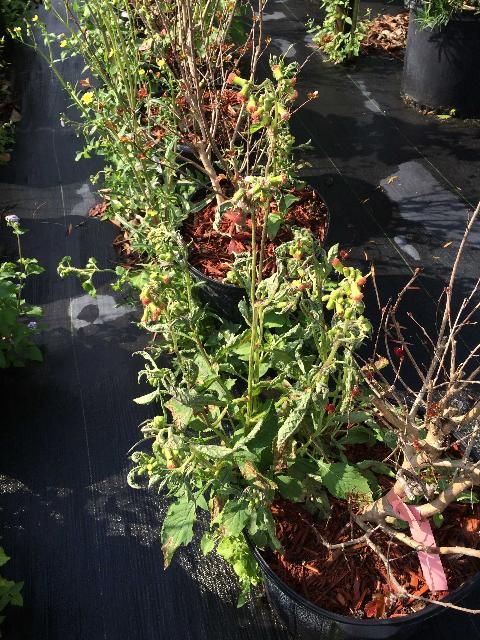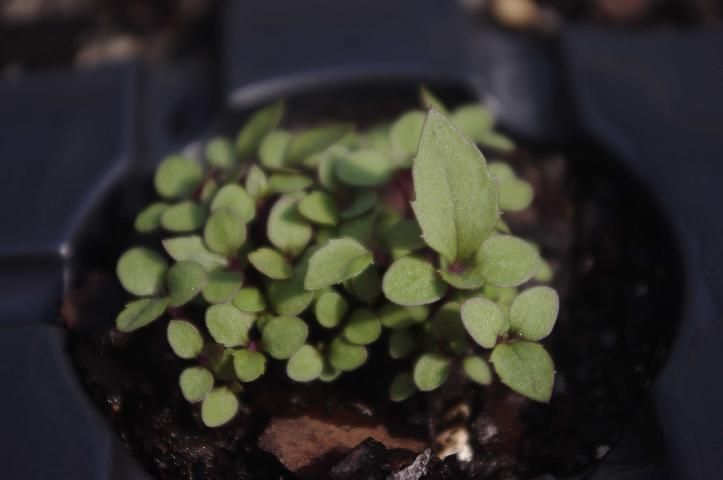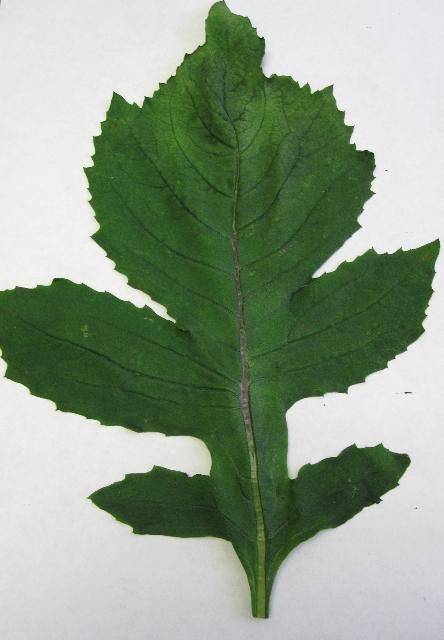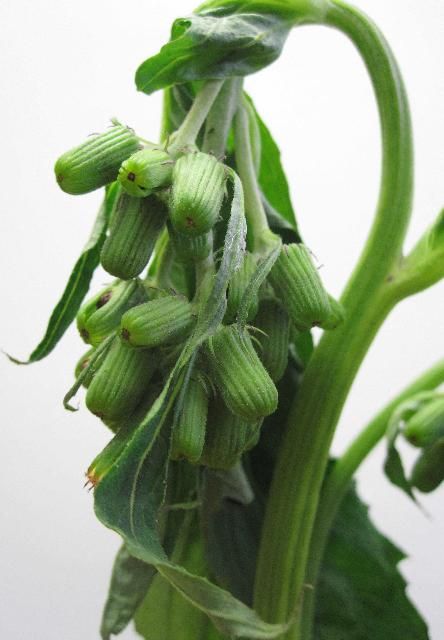Species Description: Dicotyledonous plant
Family: Asteraceae
Other Common Names: Redflower ragleaf, ebolo, gbolo, fireweed, hawksbeard velvetplant
Life Span: Summer annual (flowering and fruiting August–December)
Habitat: Occurs in moist, newly disturbed areas from spring to fall. Usually found in full sun in wet areas.
Distribution: Thickhead is native to tropical Africa, but it has been widely cultivated in Asia as a medicinal and nutritional herb. It was introduced to the United States and can be found in Florida, Hawaii, and Puerto Rico. In Florida, it has been reported in Escambia, Alachua, Marion, Hernando, Orange, Brevard, Hillsborough, DeSoto, Martin, Lee, Collier, Palm Beach, Broward, and Miami-Dade counties.
Growth Habit: Erect (upright), sparingly branched, herbaceous annual, growing up to 4 feet tall (Figure 1).

Credit: Chris Marble, UF/IFAS Mid-Florida Research and Education Center
Seedling: Cotyledons are light green with opposite, spatulate (spatula-shaped) leaves with smooth margins. The first true leaves will be light green, elliptical (oval-shaped) with toothed margins growing in a rosette. Veins are slightly red in color (Figures. 2 and 3).

Credit: Annette Chandler, UF/IFAS Mid-Florida Research and Education Center

Credit: Shawn Steed, UF/IFAS Extension Hillsborough County
Shoot: Stems are round and ribbed with short, thick hairs near the apical portion of the plant on the stem and branches. The lower plant is glabrous (smooth/without hairs). Newer leaves are alternate, green, elliptical (oval-shaped), 1.5–8 in long, and 0.4–4 in wide, with irregularly toothed margins. Leaves will be slightly lobed near the apex, with only a small pair of lobes near the base of the leaf, and deeply lobed in older growth (Figure 3).
Roots: Fibrous
Inflorescence: From summer to fall, clusters of reddish-orange to reddish-pink flower heads develop at the apex of the plant. Flowers are cylindrical, about 10 mm long and 4 mm wide. Flower heads droop downward as if from water stress during flowering (Figure 4).

Credit: Shawn Steed, UF/IFAS Extension Hillsborough County
Fruit and Seeds: Each flower head produces multiple achenes about 2 mm long that are dark-reddish brown and attached to silky hairs (pappus) that are about 9–10 mm long. The hairs allow the achenes to be wind dispersed.
Similar Species: American Burnweed (Erechtites hieracifolia) does not have leaves as thick or deeply veined as thickhead. Brazilian or Tropical Burnweed (Erechtites valerianaefolia) has more flower heads than thickhead, and the flower heads are mauve colored. Emilia (Emilia sonchifolia var. javanica) has similar features, but the flower heads do not droop and are bright pink; the leaves are more hairy than thickhead.
Plant Biology
Thickhead generally grows from spring to fall in north and central Florida and year-round in south Florida. It germinates over a wide range of pH, salt, and temperature conditions and preferentially when the seed is on or slightly below the media surface (Nakamura and Hossain 2009, Chen et al. 2009). Thickhead germination is higher in warm, saturated, or flooded conditions; as a result, it typically occurs in poorly drained fields, irrigated areas, roadsides, or during periods of heavy rainfall (Nakamura and Hossain 2009). Each flower can produce 91–150 seeds, producing up to 750–1,150 seeds per plant (Sakpere et al. 2013). Persistence in fields and container production is due to the thousands of seeds produced per plant over the course of a growing season (Nakamura and Hossain 2009). Seeds can germinate anywhere from 50°F–86°F (optimal = 59°F–68°F), at a pH of 2–12 (optimal 4–10). Seeds have a 90% germination rate from mature (wind-dispersed) seeds at 2–12 days after making contact with media (highest germination rate is day 6) (Chen et al. 2009). Flowers can set seed in 10–12 days from initial flower opening (Sakpere et al. 2013). Thickhead grows aggressively in containers and can outcompete nursery crops for water, nutrients, and light. Thickhead is typically found in shadehouses and shaded areas of nursery production.
Management
Physical and Cultural
Hand weeding when plants are small is the best physical preventative measure. Increasing light levels and reducing application of irrigation water can help prevent germination. Using a bark mulch that prevents seed-to-soil contact might prevent seed germination. If thickhead plants escape control by various methods, the plant should be prevented from flowering in the nursery or liner bank. If flower stalks are evident in a localized area and seed dispersal is imminent, as a last ditch effort some growers have cut the stalks with machetes or hedge trimmers to prevent wind dispersal of the seeds. Seed dispersal by wind will cause a wide spread problem throughout the nursery. Keeping field margins and border areas clean will help prevent seed dispersals. All liners and bought-in plants should be isolated and monitored for thickhead seedlings before being dispersed into the nursery.
Chemical Control
Preemergence
Very few preemergence herbicides labeled for use in nursery production or landscapes contain recommendations for control of thickhead. One herbicide that lists thickhead as a controlled species is flumioxazin, which is sold as Broadstar™ and SureGuard®. Broadstar™ is a granular formulation of flumioxazin and can be applied to container-grown ornamentals and to established plants in landscapes. SureGuard® is a spray-applied formulation and is only labeled as a directed application around most ornamentals. Other herbicides that provide suppression or control of thickhead include indaziflam (Marengo® or Specticle®) and products containing dimethenamid-p (FreeHand® and Tower®). Other preemergence herbicides are listed in Table 1. Additional herbicide recommendations are available at https://www.cals.ncsu.edu/plantbiology/ncsc/containerWeeds/Crassocephalum_crepidioides.htm.
Postemergence
There are many different postemergent herbicides that are effective for thickhead control, but all should be applied as a directed application. Effective active ingredients include glyphosate (RoundUp® and many other trade names), glufosinate (Finale®), diquat (Reward®), pelargonic acid (Scythe®), among several others. Both systemic and contact herbicides typically provide effective control, but thorough coverage is needed for contact herbicides such as diquat or pelargonic acid. Postemergent herbicides are most effective when the weeds are small and actively growing—this is especially true for contact action herbicides. Always consult the manufacturer's label and follow all precautions when applying herbicides.
References
Chen, Guo Qi, Shio Liang Guo, and Qiu Sheng Huang. 2009. "Invasiveness evaluation of fireweed (Crassocephalum crepidioides) based on its seed germination features." Weed Bio. And Mgmt. 9:123–128.
Mallory-Smith, C.A., and E.J. Retzinger Jr. 2003. "Revised Classification of Herbicides by Site of Action for Weed Resistance Management Strategies." Weed Technology, 17(3):605–619.
Nakamura, Ichiro, and Mohammad Amzad Hossain. 2009. "Factors Affecting the Seed Germination and Seedling Emergence of Redflower Ragleaf (Crassocephalum crepidioides)." Weed Bio. And Mgmt. 9:315–322.
Sakpere, A.M.A., O. Adedeji, and A.T. Folashade. 2013. "Flowering, Post-Pollination Development, and Propagation of Ebolo (Crassocephalum crepidioides (Benth.) S. Moore) in Ile-Ife, Nigeria." Journal of Science and Tech. 33:37–49.